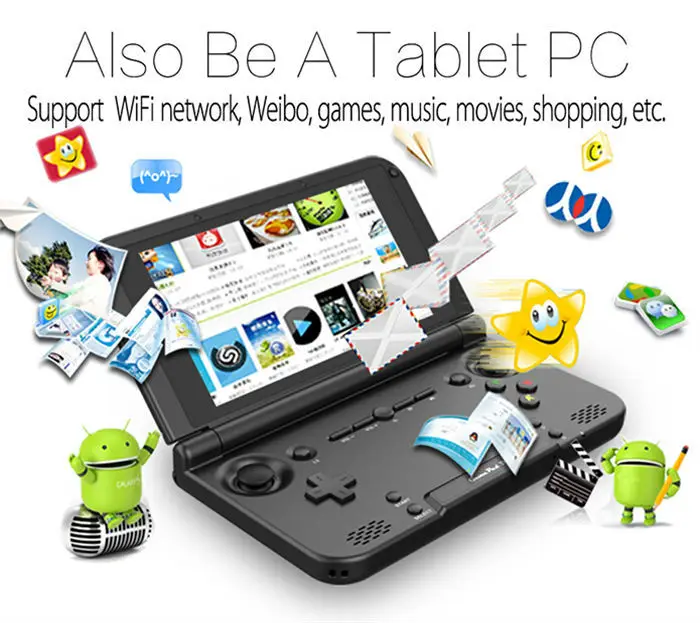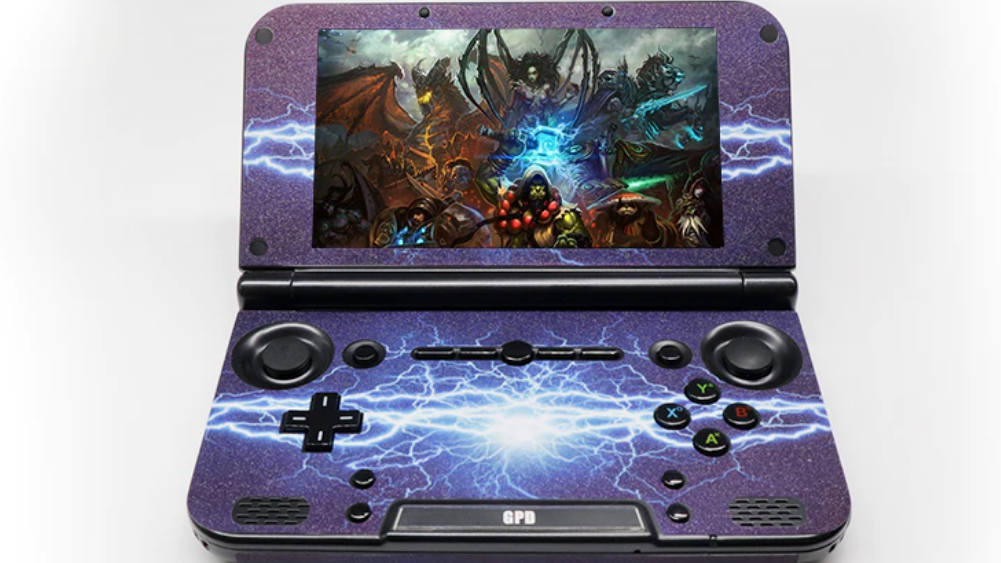GPD is a Chinese brand known for its small portable laptops and android devices. They have also ventured into the retro handheld console realm and the result would be the GPD XD Plus.
If you’re wondering whether the “XD” in the GPD XD Plus is intentional, then the answer is yes. The very front of the retail box has a character laughing with that exact same face.
Inside the box, you get a clamshell handheld console reminiscent of the Nintendo 3DS with its flip-open design. This makes for great portability and durability at the same time.
However, with a price tag of $250, the XD Plus is certainly not one of the best retro handheld options in the market for its lack of quality. It lags behind the competition with its sluggish UI, average emulation, and build quality that does not live up to the price tag at all.
Here are the specifications:
| Product Specs: | Details: |
|---|---|
| CPU | 1.5GHz quad-core CPU and an ARM Mali 450 GPU |
| RAM | 1 GB |
| Storage | 64-256 GB |
| Ports | 1 HDMI, 2 USB-A |
| Price | $50-$80 depending on the storage |
Pros
- Good battery life
- Portable and durable design
- Large screen with high resolution
Cons
- Overpriced
- Sluggish UI
- Mediocre performance
Screen

One of the best features of the GPD XD Plus is definitely the large display. It is a 5-inch IPS LCD touchscreen with 720p resolution, making it bigger and more detailed than a lot of retro handheld consoles.
This screen is bright and colorful and an absolute treat to play on with great colors. It works well under bright light as well as darker environments. Since it is a touchscreen, navigating through the UI is quite easy, unlike some other Android-based handhelds that make it difficult without any touch screen support.
However, some games do not benefit from the large screen and high resolution as the aspect ratio does not fit properly. This adds black bars to the corners of the display, but this can easily be fixed through the settings.
Design and Build Quality

Once you flip open the handheld, you are greeted with a cluster of buttons at the bottom with absolutely nothing in the middle, just a big empty space making it look like something is missing. The top part is almost entirely covered by the admirable screen.
The buttons themselves are quite average, like any other standard Chinese handheld, which do not justify the $250 price tag whatsoever. The joysticks, however, are quite nice and comfortable to play with. They are rubberized and placed well on the device, making for a great gaming experience.
Regardless of the average build quality, the GPD XD Plus is quite comfortable to use since it fits in your hands quite smoothly. All of the buttons are easy to reach and nothing is awkward to use since everything is placed adequately.
Not to mention the clamshell design makes the handheld quite pocketable and durable. One of the main reasons why the foldable handheld design is quite popular among fans.
Performance

Emulation performance is certainly not the strongest suit of this console. It is powered by a 1.7GHz MediaTek CPU alongside the PowerVR GX6250 GPU and 4GB LPDDR3 RAM. All of this sounds great on paper and does actually perform well in some titles, but lacks on bigger consoles such as the PS1, PSP, Sega Dreamcast, which is quite underwhelming for a $250 handheld.
Most Android games perform okay on this device including the wide variety of pre-loaded games it comes with. This includes Gameboy, Gameboy Advance, SNES, NES, and Mega Drive games. All of these will work pretty well but PS1 and Dreamcast games are very annoying to play. These games will have severe frame drops, audio issues, visual glitches, limited save files, and more, so you’re better off sticking to pre-loaded games and Android games.
It is worth mentioning that the performance heavily depends on the quality of apps you get from the Android app store. Most of the free ones lack quality emulation so you will have to spend a bit of money before you can get some reliable emulation out of this handheld.
Software and UI

The GPD XD Plus boots Android 7.0 (Nougat) out of the box, which is a heavily outdated OS that Android has already stopped updating. This means the UI will be incredibly laggy and you may also see frame drops in games if you pick up the XD Plus right now.
The UI is entirely in Chinese by default and even if you manage to change the language somehow, most of the text on the screen will still be Chinese.
The interface itself is very easy to navigate and works well with the touchscreen functionality. The pre-loaded games are neatly arranged in different tabs for different consoles, but you will need third-party apps from the Android app store to emulate your own ROMs. As mentioned earlier, the quality of emulation heavily depends on emulator apps you grab from the app store.
Also, if you want to switch to a more usable front end that does not lag all the time, you will need to put in hours of research before you can get something done. This has been one of the biggest criticisms of Android-based handhelds for ages.
Verdict
Our review may make it seem like the GPD XD Plus is the worst handheld to play games on, but that is not the case. It is not a bad console and you can have a good time playing games on it, it is just incredibly overpriced for something that is already outdated.
In short, it is not a great option in 2021 and you’re better off picking an Anbernic or a Retroid handheld for a much lower price. If the GPD XD Plus was priced around the $100 range, then it would easily be one of the best options in the market.
But, alas, you cannot win them all.
FAQs
Is the GPD XD Plus worth it?
The GPD XD Plus is certainly not worth it in 2021. The software is outdated and the performance and build quality does not justify the $250 price tag.
When did the GPD XD Plus come out?
The handheld came out in 2015 as an update over the regular GPD XD. It runs Android 7.0 on boot and cannot be updated to the latest Android version.
What can the GPD XD Plus emulate?
The console can easily run Gameboy, Gameboy Advance, SNES, NES, and Mega Drive games, but will struggle with bigger consoles such as the PS1, Sega Dreamcast, PSP, etc.





